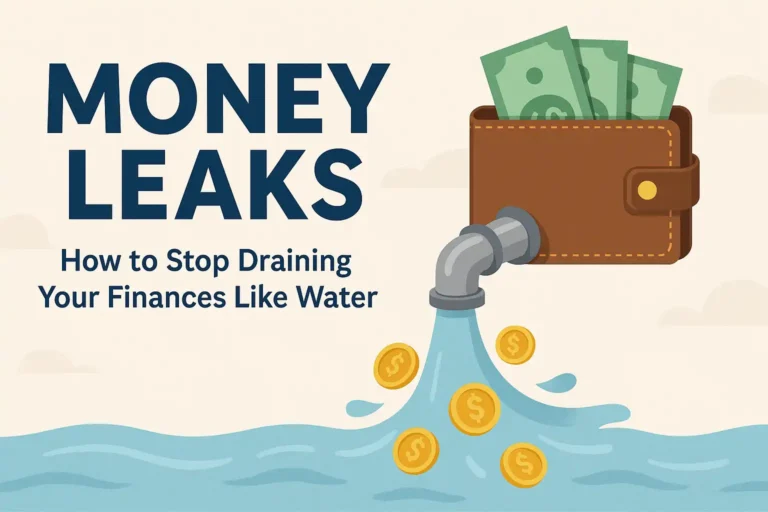Originally Published: March 2025 | Last Updated: August 2025
Why this matters now.. Like a Financial Airbag
Picture this: A time when a sudden job loss or an unexpected medical bill does not send your heart racing because you already have six months of living expenses tucked safely away. In today’s unpredictable world, building a 6-month emergency fund is not just a “nice-to-have”—it is a financial necessity.
Here is a gut punch: 56% of Americans can’t cover a $1,000 emergency with savings. An emergency fund does exactly that: it turns panic into a plan. Think of it like stocking water in a desert — a small, steady habit today can save you from a crisis tomorrow. Realistic working ways to protect your family from expenses like medical bills, job loss, or urgent home repairs. By the end you’ll have an actionable emergency savings guide and clear emergency fund goals you can start hitting this week.
Understanding the Importance of a 6-Month Emergency Fund

Having an emergency fund is like wearing a seatbelt on a winding road—you hope you never need it, but when you do, it makes all the difference. Here is why a 6-month emergency fund is a game changer:
Financial Security: It provides a cushion during unforeseen events, such as sudden unemployment or emergencies.
Peace of Mind: Knowing that you have enough saved can reduce stress and help you focus on long-term financial goals.
Avoiding Debt: With adequate savings, you are less likely to rely on high-interest loans or credit cards when emergencies arise.
Many households are underprepared: surveys show that a large share of adults lack sufficient emergency savings to cover three months — and a significant portion can’t cover a $1,000 surprise without borrowing. These numbers highlight the practical value of acting now.
1. How much do you really need? (Math (Calculate Your Target) + the 3-6 rule)
Industry guidance usually recommends 3–6 months of living expenses; for many households, a 6-month emergency fund is the sweet spot because it covers income shocks and longer job searches. Recent national data show fewer than half of adults have three months’ savings — a reminder that building this cushion matters.
Practical approach — Calculate your target:
• List recurring monthly expenses (rent/mortgage, utilities, groceries, minimum debt payments, insurance).
• Multiply by 6 = your 6-month emergency fund goal.
Consider the pragmatic 3-6 rule (an easy structure to balance access and return): keep part of your reserve in 3 places and which is the 6 times of your monthly expense:
— Immediate-access high interest savings account
— A sweep-in fixed deposit that breaks automatically when needed
— A liquid mutual fund as backup. This preserves liquidity while adding a touch of yield.
2. Why the fund protects you — mini case studies
• Medical surprise avoided: Rhea’s child needed urgent dental work. Instead of a credit-card scramble she tapped her emergency fund, paid the dentist, and avoided interest charges. The fund kept her credit score intact and her stress low.
• Job transition buffer: Sameer lost a client for three months. Because he had a 6-month emergency fund, he could focus on pitching new clients rather than taking the first low-paying gig that came along.
Those are not feel-good hypotheticals — they are proof that a properly sized emergency fund turns expensive choices into calm decisions. Use these stories as models for your own emergency fund goals.
3. How to build an emergency fund — a realistic, step-by-step plan
This emergency fund step-by-step roadmap shows small actions that compound into big security.
Step 1️⃣: Know your number:
Your emergency fund is not for weekend getaways or impulse Amazon buys. It is bare-bones survival mode.
• List Essentials Only: Rent, utilities, groceries, insurance, debt payments.
• Multiply by 6: (Example: $3,200/month x 6 = $19,200).
• Set Timeline: Set a realistic timeline for achieving this goal.
Step 2️⃣: Assessing Your Current Financial Situation
Step-by-Step Process:
1. Create a Detailed Budget:
• Write down your income sources and monthly expenses.
• Identify variable costs that you can adjust, like dining out or subscriptions.
2. Analyze Your Spending Habits:
• Track your expenses for one month to spot patterns.
• Categorize your spending to see where you might cut back.
3. Set a Clear Savings Goal:
• Calculate the exact amount needed for your 6-month emergency fund.
• Break this target into monthly or weekly savings goals.
Step 3️⃣: Developing a Savings Plan That Works for You
Creating a savings plan is the bridge between understanding your finances and building your fund. Here’s how to craft a plan that suits your lifestyle and goals.
- Create a “no-touch” account: Open a separate high-yield savings or money market account labeled “Emergency Fund.” Keep it separate from checking to avoid accidental spending and let it earn modest interest.
- Automate small, frequent deposits: Set an automatic transfer on payday — even $25–$100 per paycheck adds up. Automation works because it removes friction and temptation (behavioral finance in action).
- Use windfalls smartly: Direct tax refunds, bonuses, or gifts into your emergency fund first until you reach a three-month buffer, then continue regular savings toward six months.
- Trim one habit, redirect the money: Cut a subscription or eat out one fewer time per week; funnel savings straight into your emergency fund.
- Boost Your Income: Consider side gigs or freelancing to increase your cash flow, Also Use your skills to monetize hobbies or explore part-time opportunities.
- Reward Yourself Wisely: Celebrate milestones without derailing your progress. Use small, affordable rewards to maintain motivation without sacrificing your savings goals.
Why this works: automation removes decision fatigue; separation reduces the urge to spend; and micro-changes avoid the “sacrifice” feeling so common in “save more” plans.

4. Where to keep it (safety + liquidity)
Your emergency fund must be accessible and safe—no stock market rollercoasters. Keep funds in FDIC-insured high-yield savings accounts, money market accounts, or short-term sweep instruments. These give liquidity and a little interest without risking principal. Avoid volatile investments for this money; you need the cash, not the gamble.
Quick checklist:
• FDIC/insurer coverage? ✅
• Can you withdraw within 24–72 hours? ✅
• Is it labeled and separate from everyday checking? ✅
5. Pro tips & common pitfalls (so you don’t sabotage your progress)
• Pitfall — putting it in stocks: Resist the temptation to chase higher returns. A market drop can leave you cash-poor when you need money most. Keep the emergency fund liquid and conservative.
• Pitfall — lifestyle inflation: As income rises, don’t let your savings rate fall. Increase your automated transfer when your paycheck grows.
• Pro tip — tier your fund: Keep 1 month of immediate cash at home/bank, 2–3 months in an online high-yield account, and the rest in a slightly higher-yield but liquid option — the 3-6 structure again.
• Pro tip — use clear labels: Name the account “Emergency Fund — Do Not Touch” so transfers feel more official and less optional.
6. Psychological hacks that make saving effortless
• Treat saving like paying yourself: Make it a recurring bill.
• Visual progress: A progress bar, chart, or app that shows % to goal gives dopamine hits and keeps you motivated.
• Accountability partner: Tell a friend or partner your timeline — social commitments increase follow-through.
Tips for Effective Tracking:
- Use Digital Tools:
• Apps like Mint or YNAB (You Need a Budget) can help monitor your progress in real time.
• Set reminders to review your budget and savings goals monthly. - Regularly Reevaluate Your Goals:
• Life circumstances change, and your emergency fund should reflect your current needs.
• Update your savings target if your monthly expenses increase. - Celebrate Milestones:
• Acknowledge each step you take, whether it’s reaching 25%, 50%, or more of your goal.
• Use visual progress trackers like charts or graphs to maintain your motivation.

Most searchable FAQs;
1. What exactly is an emergency fund and why do I need one?
An emergency fund is a financial cushion that covers life’s unexpected expenses—job loss, medical bills, urgent car repairs, or household breakdowns. Without it, many people end up relying on credit cards or loans, leading to high-interest debt. The biggest reason why you need an such fund is peace of mind. It acts as a safety net, ensuring that emergencies don’t derail your long-term financial plans.
2. What is the 3-6-9 rule for emergency funds?
The 3-6-9 rule is a simple way to set your goals based on your financial stability:
• 3 months of expenses if you’re single with a stable job.
• 6 months if you have dependents or moderate job security.
• 9 months if your income is irregular, you’re self-employed, or your family relies on one earner.
This step-by-step approach helps you decide how to build an emergency fund that truly fits your lifestyle.
3. How much should I put in my emergency fund per month?
There’s no one-size-fits-all answer, but a good rule is to save 10–20% of your income toward your emergency fund until you hit your target. If your monthly expenses are $2,000 and your goal is a 6-month emergency fund ($12,000), saving $500 each month will get you there in two years. Even small, consistent deposits help you start emergency savings and build momentum.
4. Is a 3-month emergency fund enough?
For some, yes—but for most households, a 6-month emergency fund is safer. A 3-month fund works if you have a stable job and few dependents. However, if you have kids, a mortgage, or uncertain job security, extending it to 6 or even 9 months adds stronger protection. Your emergency savings guide should always consider your personal circumstances.
5. How much emergency fund is sufficient?
The “sufficient” amount depends on your lifestyle. Start by adding up your essential expenses—housing, food, utilities, insurance, and transport. Multiply that by 3, 6, or 9 months depending on your risk tolerance. For instance, if your monthly expenses are $3,000, a 6-month emergency fund means saving $18,000. Setting realistic emergency fund goals makes sure your savings align with your needs.
6. What percentage should go into an emergency fund?
Most financial experts recommend allocating 10–15% of your monthly income until your fund is fully built. If you’re already investing or paying debt, aim for at least 5% to steadily grow your emergency fund without straining your budget. Remember, consistency is more important than large, irregular deposits.
7. What is the average emergency fund in the US?
According to recent surveys, the average emergency fund in the US is around $5,000–$8,000. However, many households don’t even have $1,000 saved for emergencies. This gap highlights the importance of following an emergency savings guide and building your own security net instead of relying on averages.
8. Can I invest my emergency fund?
Generally, no. The goal of an emergency fund is safety and liquidity, not high returns. You should avoid risky investments like stocks or crypto for this money. Instead, keep it in a high-yield savings account, money market account, or short-term certificates of deposit (CDs). These keep your money accessible while offering modest interest. Best way to keep an emergency fund is where it’s safe and available instantly.
9. Best way to keep an emergency fund?
The best option is a separate high-yield savings account that is FDIC-insured. This separation prevents you from dipping into it for non-emergencies. You could also use money market accounts for a balance of access and returns. The key is to avoid accounts linked to daily spending, so your emergency savings guide remains untouched until truly needed.
10. Emergency fund from government—does it exist?
Governments don’t provide a personal emergency fund for individuals. However, during crises like COVID-19, governments may offer stimulus checks, unemployment benefits, or relief programs. These can temporarily support you but shouldn’t replace your personal emergency fund goals. Relying solely on government aid leaves you vulnerable.
11. How much should a 30-year-old have in an emergency fund?
By age 30, it’s recommended to have at least 3–6 months of expenses saved. If your expenses are $2,500 per month, aim for $7,500–$15,000. Since this is also the time when many face milestones like marriage, buying a home, or starting a family, having a strong emergency fund provides a solid base to handle both opportunities and challenges.
Conclusion — Start today, feel secure tomorrow
Building a 6-month emergency fund is not about deprivation—it is about empowerment. By knowing your number, automating contributions, keeping funds liquid, and avoiding common pitfalls, you can build emergency fund momentum that protects your life and your choices. Every dollar saved is a middle finger smile to life’s plot twists. Start today, even if it is $10.
Remember:
Progress > perfection.
Small steps > no steps.
Treat your emergency fund as a non-negotiable part of your financial plan — not a “maybe” when things are easy. The peace you buy with consistent saving is worth more than short-term comforts.
You now have an emergency savings guide and a practical map for how to build an emergency fund. Take the first step — your future self will thank you.
P.S. Still sweating over budgeting? Master the basics with our viral post: [“Building Wealth Through Real Estate Flipping”].







